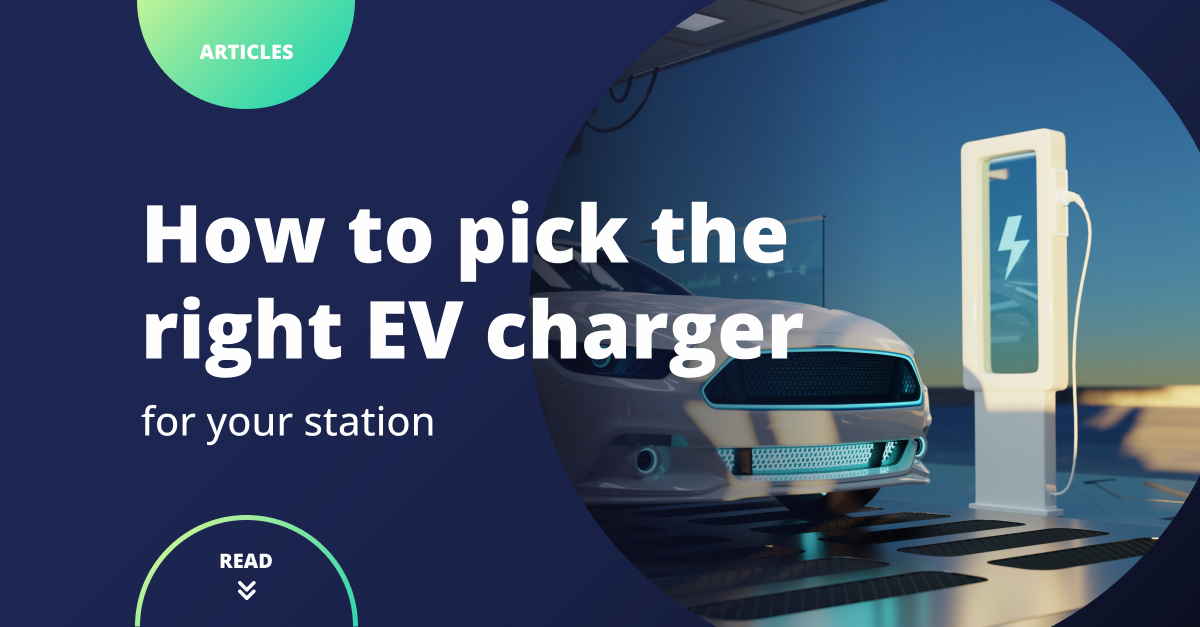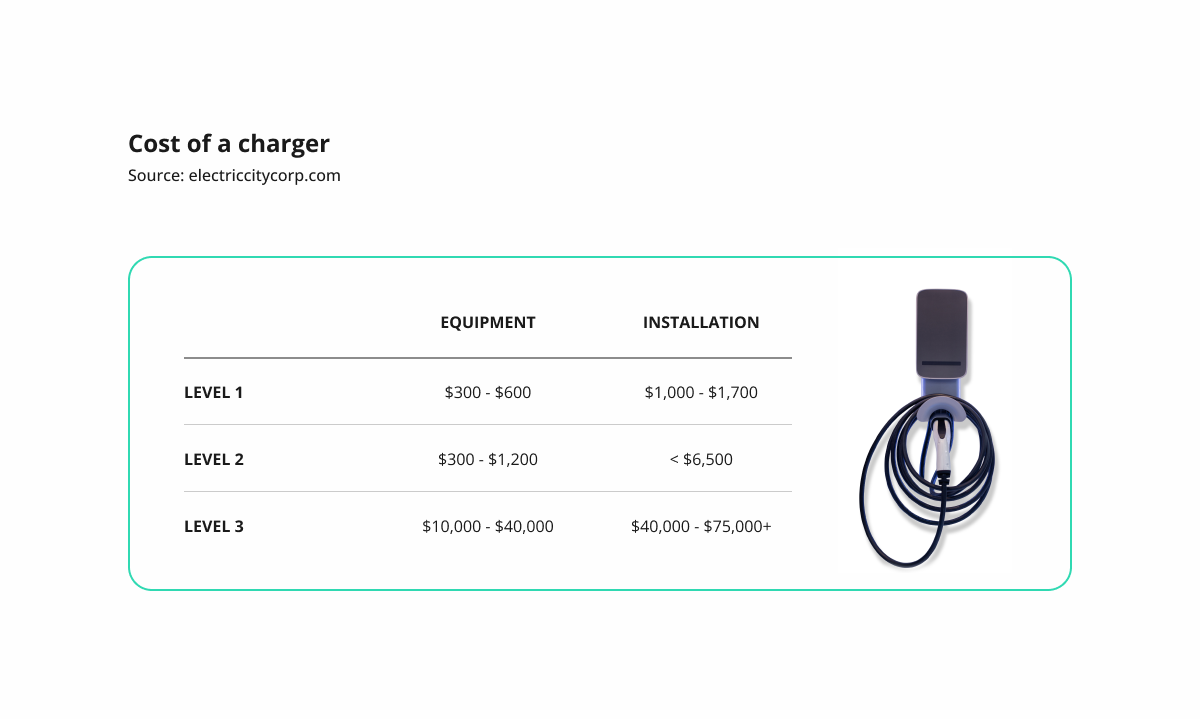How to pick the right EV charger for your station

One of the most common worries of people considering buying an electric car is that they will run out of power without a charging station in sight. Inside Volvo’s survey, we can find that 58% of drivers avoided buying an electric car because of this fear. From a Forbes report meanwhile, we can learn that 25% of EV drivers said they are worried about whether they have enough power in their vehicle every time they drive – and 37% said they are worried very often.
To reassure both the existing and future EV drivers that they can drive without worrying about their batteries, we need to build more charging stations. However, setting up a commercial charging station isn’t an easy task – especially when it comes to choosing one out of many EV charger types.
To help you determine what you need and choose the best charging equipment for your station, we’ve created a guide on available EV chargers and what to consider while buying those.
What are the main types of EV chargers?
The first thing we will be talking about is what types of chargers you can pick from. EV chargers may seem similar, but they differ in functionality, charging speed, and installation cost. Which type of charger is used in public stations also depends on the country, as there are different connector types used in different regions.

Currently, EV chargers belong to three groups:
Level 1 chargers
Those are the slowest chargers available, charging around 8 km per hour. Charging to full might take around 40-50 hours for Battery Electric Vehicles (depending on the capacity) and 5-6 hours for plug-in hybrid electric vehicles. Level 1 chargers are mainly used in the United States as they use a standard US 120 V outlet. Only around 2% of the chargers in the US are Level 1 though, most of which are used at homes.
Level 2 chargers
Level 2 charging is the most commonly used charger type nowadays as they are much faster than Level 1 chargers. Level 2 chargers use a 240V outlet and can charge about 30 km per hour. That way, they only need about 6 to 14 hours to charge a battery EV fully and 4 to 8 hours for a plug-in hybrid. That makes them ideal for charging the EV car overnight or, for example, for a quick charge while the EV drivers are in a store or restaurant.
Level 3 chargers
The last of the three levels of electric car charging is Level 3, often called DC Fast Charging. Level 3 chargers use Direct Current (rather than alternating current like Level 1 and 2) and a 480 V outlet. With so much power, Level 3 chargers can charge 5 to 32 kilometers per minute (yes, minute, not hour!), so they usually need a couple of minutes to charge a car to full.
How much does each of the charger types cost?

Since Level 3 chargers are the fastest charger type and as such, the most convenient type for EV drivers, choosing and installing those might seem like the most logical choice. The faster EV drivers can charge their cars, the more customers your station can serve in a day and the more you will earn, right?
Unfortunately, there’s a significant reason why only 18.5% of ports in the United States and around 1 in 7 chargers in Europe are level 3 chargers. Namely, the installation costs and the fact that not all electric vehicles support DC charging yet.
Let’s first look at the costs involved with Level 1 and Level 2 chargers though.
Level 1 chargers cost
Level 1 charging equipment typically comes together with the EV car, so EV owners don’t have to pay extra for a charging station. Instead, the car just needs to be plugged into the electric outlet, and it will start charging. And while the charging might be slow, this type can be the cheapest and easiest way to charge for people who don’t use the car daily. A commercial Level 1 charger meanwhile costs between $300 to $600 for equipment and around $1,000 to $1,700 for installation costs.
Only a few public charging station use Level 1 chargers though, as they are far too slow to use – imagine waiting 40 hours at a public station just to charge your car!
That’s why Level 1 chargers are mostly used at home, while public charging stations mainly use Level 2 chargers.
Level 2 chargers cost
Level 2 chargers are much more powerful than Level 1 charging stations, as they only need 6-8 hours to charge a battery to full, not around 40.
Installing level 2 chargers is a bit more complicated though. While the equipment cost is typically around 300-$1,200, you also need to factor in the cost of hiring dedicated technicians to install those. CyberSwitching estimates that a single level 2 charger might cost up to $6500.
The end cost might be higher though if some of your existing electrical outlets have to be replaced or, for example, you need to change your current circuit board to handle the load.
Level 3 chargers costs
If you multiply the cost of Level 2 chargers by 5 or 10 stations, the price might seem staggering. However, that’s still much lower than the cost of Level 3 chargers though, as those might cost from $30,000 to even $75,000 per unit.
From where this massive cost comes? There are a few reasons. First, level 3 chargers can charge so fast because they can convert the AC power into DC power straight at the charger – compared to Level 1 and 2 chargers, where the energy has to be transformed inside the electric vehicle. For the conversion though, Level 3 chargers need to use the converter hosted inside the charging station – and that makes the stations both much larger and more complicated to install than Level 2 chargers. The equipment for Level 3 station is also much more advanced – and expensive.
For example, the EV charging cables for fast charging stations must be much thicker and have a special cooling system included to allow them to handle the voltage coming from 470V outlets. Installing level 3 chargers might also require upgrading your electrical infrastructure to handle the high voltage required by the chargers. You will also need to factor in the costs of dedicated charger software, eventual customization, branding, regular infrastructure maintenance, and security checks.
Because of those costs, level 3 chargers are mainly only installed in places with very high traffic, like highway charging stations and rest stops or large shopping malls.
One more problem with Level 3 chargers is that while levels 1 and 2 can be used by virtually all EV cars, not all vehicles are compatible with Level 3 chargers. Plug-in hybrid electric vehicles, for example typically can’t use Level 3 chargers, and some EV batteries can’t handle the charge output from DC charging either. Moreover, level 3 chargers use two different connector types – CHAdeMO or CSS.
Since the connectors are non-interchangeable, a car with a CHAdeMO port cannot charge with a CSS plug, and vice versa.
With all those challenges combined, planning and building a Level 3 charger installation takes a lot of time and requires a significant investment. That’s why in 2022, only around 10,000 Level 3 chargers were added to the United States charging network, compared to almost 55,000 Level 2 chargers.
What else should you check while looking for EV chargers?
So how can you figure out which of those three charger types you should use for your charging station? The best way here is to thoroughly research who will use your charging station, how often they’ll use it, and what speed they’ll need.
In most cases, a level 2 charger should be more than enough, as they will allow people to charge their cars to full while at work or, for example, during an overnight stay at a hotel. Plus, level 2 chargers are also more affordable and easier to install than DC chargers.
In some cases though, it might be a good option to combine AC and DC charging stations – especially when you can expect that your station will be used by people who will want to charge their cars for longer journeys.
Since even a single Level 3 charger might require a significant upfront investment though, you should calculate carefully first whether there will be enough drivers using the fast charging to justify the installation and maintenance expenses.

As you are looking at specific EV charging stations equipment providers option, we would recommend also checking a few other things:
Physical Equipment
- The quality of materials used and the physical durability of the charger equipment (especially important if you are considering a level 3 charger).
- The performance of the EVSE equipment included with the charger (electrical conductors, dedicated software, communications protocols, and any related equipment).
- Are the charging cables working as tethered (permanently attached to the station) or untethered (with a socket to which the EV drivers can connect the cables)? In the case of tethered ones, you should also check the cable length.
- Weather resistance and optimal temperature range of the charging equipment (and how the chargers might behave when, for example, they are overheated).
- Is the charging equipment compliant with the EV industry equipment standards?
Connectivity
- What communication channels do the chargers use, and can those be modified (as some manufacturers might set their own communication channels and only allow to access and modify the system through, for example, their cloud)
- Do the chargers support Open Charge Protocol (not all chargers support it yet, though it slowly becomes a standard. California, for example, set OCPP 1.6 as a mandatory requirement for all new stations as of September 2022). If yes, then you might also want to check how the chargers/software will gather and share information and how the entire system is secured from potential attacks.
- Is it possible to enable/disable charging authorization methods as needed, (for example, authorize all without communication with the server, RFID with a local list, RFID validated on the server) with a ChangeConfiguration OCPP message?
- What types of Charging Profiles and Charging Schedules does the charging station support, and can those be customized?
Conclusion
Now that you learned what to consider when buying a new commercial EV charger for your stations, it should be easier for you to choose the charger types or a combination of chargers that suits your needs the most. What’s important here is to think about your potential EV station users’ needs first – whether most of them will want to quickly charge their car and continue driving or maybe they’d rather leave the car to charge while they are at work.
Plus, you should also carefully examine how the charging station equipment itself will work – both the physical parts and the software/connectivity features. With thorough research done though, you’ll be able to choose the chargers that will help you bring more drivers to it – and this way, grow your station.
contact us
Need expert guidance on your next energy project?
Reach out to us and discover how Codibly can offer tailored solutions to drive your business.